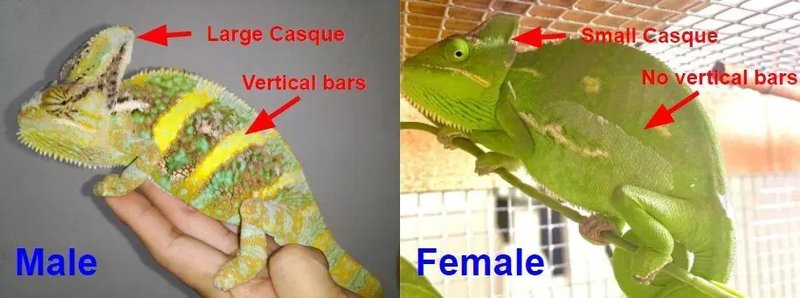
So, let’s talk about some of the ways you can tell if your veiled chameleon is male or female. Picture this: two chameleons basking under the sun, each displaying their unique traits. The male might stand tall and vibrant, while the female could be a little more subdued. Together, they create a stunning picture of the species’ diversity. Keep reading to uncover the visual clues and behavioral traits that will help you determine the gender of your veiled chameleon.
Understanding the Basics of Veiled Chameleons
Veiled chameleons, also known as *Chamaeleo calyptratus*, are native to Yemen and Saudi Arabia, and they’re popular pets due to their striking colors and unique personalities. They can showcase an array of vibrant hues, making them visually stunning to observe. Understanding these lizards’ characteristics is essential for discerning their gender.
First off, males tend to be larger than females. They can reach up to 2 feet long, while females usually max out around 1.5 feet. This size difference can be dramatic, especially when they’re side by side. You might also notice that males often have a more pronounced “crown” or helmet on their heads, giving them an extra splash of character.
Additionally, both genders can change colors based on mood, temperature, and health, but males are typically more colorful and vivid. This dazzling display can be a real treat to watch as they go from bright greens, blues, and yellows to deeper shades. So, keep an eye out for those telltale signs!
Physical Characteristics to Look For
When trying to determine the gender of your veiled chameleon, you’ll want to focus on specific physical traits. While it can be tricky, especially for beginners, these features can help make it clearer.
One noticeable feature is the hemipenal bulge located near the base of the tail in males. This bulge is absent in females. If you look closely at your chameleon while it’s perched, you might spot this characteristic if they’re male. It’s a defining feature because it becomes more pronounced as they mature.
Another aspect to consider is the coloration. Males are often more vibrant with brighter colors, especially during mating season, while females may appear more muted. Their colors can also change based on stress or health, but this general trend usually holds true.
Lastly, observing body shape can provide clues as well. Male veiled chameleons generally have more robust, stocky bodies compared to their slimmer female counterparts. So, if you’re seeing a chameleon that looks more petite and delicate, there’s a good chance it’s a female.
Behavioral Differences Between Genders
Aside from physical characteristics, the behaviors of male and female veiled chameleons can be quite telling. Male chameleons tend to exhibit more aggressive behavior during mating season. They may display certain posturing like puffing up and changing colors to attract females or ward off rivals.
You might notice males being territorial, especially in their environment. They can sometimes be more active and adventurous, exploring their surroundings with an air of confidence. If your chameleon is constantly on the move, it could be a male enjoying its space.
In contrast, females often show different behaviors. They can be more reserved and shy, especially when feeling stressed. If a female feels threatened, she might change to a darker color as a way to communicate her discomfort. If you find your chameleon hiding more often, it might be hinting that it’s a female.
Age and Maturity: When to Check for Gender
Determining the gender of a veiled chameleon isn’t always straightforward, especially when they’re young. Juveniles can be particularly difficult to identify, with their features not fully developed until they reach maturity.
Generally, you can start accurately identifying the gender around 6 months of age. Before that, both males and females will look similar, making it tough to give a definitive answer. Once your chameleon reaches about 6 months, it’s a good time to start looking for those distinctive physical traits and behavioral cues.
If you’re still unsure, consider consulting a vet who specializes in reptiles. They can help with any questions regarding your veiled chameleon’s age, health, and ultimately, its gender.
Creating the Right Environment for Each Gender
Knowing the gender of your veiled chameleon can significantly affect how you set up its habitat. This is particularly true if you plan on breeding or if you want to ensure the comfort of your pet depending on its gender.
For a male chameleon, providing a larger space is ideal. They thrive in a more expansive environment where they can show off their territorial nature. This means adding more climbing structures and creating a visually stimulating habitat.
On the flip side, females require specific care, especially if you’re considering breeding. A proper nesting area is essential for a female chameleon that produces eggs. If she feels safe and has a place to lay eggs, she’s more likely to thrive.
Ensuring that both genders have access to the proper lighting, humidity, and temperature will keep your chameleons happy and healthy.
So, when it comes down to telling the gender of a veiled chameleon, it’s all about observing those physical and behavioral characteristics. From the prominent hemipenal bulge in males to the more muted colors of females, these traits can help you identify your pet’s gender with confidence. Remember the tips discussed, and soon enough, you’ll be able to look at your chameleon and say, “Yep, you’re a male” or “Hello, beautiful female!”
Understanding the gender of your veiled chameleon not only enriches your bond with it but also enhances its care and overall well-being. Keep observing, enjoy the journey, and let the colorful world of veiled chameleons captivate you!
